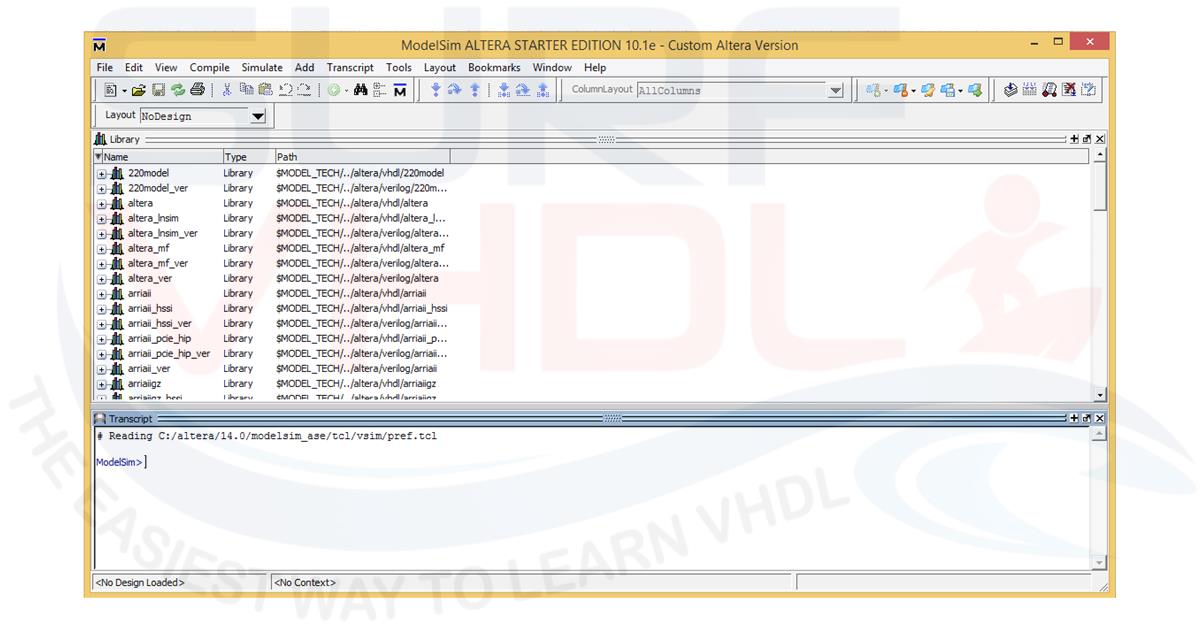

- INSTALLING MODELSIM ALTERA VHDL MODEL FILES MAC OS
- INSTALLING MODELSIM ALTERA VHDL MODEL FILES INSTALL
- INSTALLING MODELSIM ALTERA VHDL MODEL FILES SERIAL
- INSTALLING MODELSIM ALTERA VHDL MODEL FILES DRIVERS
- INSTALLING MODELSIM ALTERA VHDL MODEL FILES UPDATE
INSTALLING MODELSIM ALTERA VHDL MODEL FILES SERIAL
Select the serial entity (Design Unit(s) = rial) and click to begin simulation. You will see three entities available for simulation: FSM, serial, and shift_reg.To select this entity, scroll down and locate the tutorial library and click on the plus (+) sign.In this tutorial, simulate a entity called serial. In the Design tab you will see a list of libraries and entities you can simulate.For the purposes of the functional simulation, we only need to look at the Design tab. The window to start simulation consists of many tabs.Put Modelsim in simulation mode by selecting.A green check mark will appear to the right of the serial.vhd file in the Project tab. Project name = serial_adder, project location /Using_ModelSim/functional default library name Compile All]. To create a project in ModelSim, select.PASSO 2 - Functional Simulation with ModelSim Creating a Project

Em seguida abra o ModelSim ( Tools > Run Simulation Tools > RTL Simulation). Em seguida faça a ( Processing > Start > Analysis & Synthesis) do projeto.
INSTALLING MODELSIM ALTERA VHDL MODEL FILES MAC OS
Since v4.2.0, the firmware fixes a bug, which would not let the board to be programmed in High-speed on Linux and Mac OS systems. If you have problem programming your board, verify that you have the last firmware version (look at this page).
INSTALLING MODELSIM ALTERA VHDL MODEL FILES DRIVERS
You can follow the same steps as described in the On Windows or On Linux sections for Quartus and drivers installation. If you are on Mac OS, a solution is to use a virtual machine running Windows or Linux. quartus/bin/jtagd: 59: ARGV=/home/user/.nf: not found quartus/bin/jtagd: 59: ARGV=-config: not found quartus/bin/jtagd: 59: ARGV=-user-start: not found Sudo sed -i 's/\/proc\/bus\/usb\/devices/\/dev\/bus\/usb\/devices\d0/g' /quartus/linux/jtagd Note that these commands will create a backup copy of the JTAG server ( jtagd.bak). If you have a doubt, it won't harm to patch both files.īefore executing the commands, replace by your installation path (e.g., /opt/altera/10.0). Select the set corresponding to your system. There are 2 sets of commands, one for 32-bit OS and the other one for 64-bit. Now we will use sed to replace the paths that the JTAG server is looking at. This soft link will disappear on reboot, so if you don't want to type it every time, add this line in a script or in your /etc/rc.local file (without the sudo). Sudo ln -s /sys/kernel/debug/usb/devices /dev/bus/usb/devices It is generally found in C:\altera\="6001", MODE="0666"įor older Quartus versions than 11.0, we need to patch the JTAG server to look for devices in /sys/kernel/debug/usb/devices instead of /proc/bus/usb/devices, and in /dev/bus/usb/././ instead of /proc/bus/usb/././.Īs the former won't fit in the string placeholder of the binary file, we choose to create a soft link. Select the usb-blaster folder from your Quartus install. Windows should ask you for the location of the drivers.
INSTALLING MODELSIM ALTERA VHDL MODEL FILES UPDATE
If you are updating a previous version of Quartus II, do not forget to update the USB-Blaster driver accordingly or you may experience strange behavior from JTAG based features.
INSTALLING MODELSIM ALTERA VHDL MODEL FILES INSTALL
But before being able to program the board you will need to install the drivers. (No need to open the subscription page request). At the end of the installer you can run Quartus II.Note that it is possible to add more components later on.ModelSim-Altera Starter edition (Free).Execute the installer and follow the instructions until you reach Components Select.Go to the Download page of the Quartus II Web Edition here and download it.


 0 kommentar(er)
0 kommentar(er)
